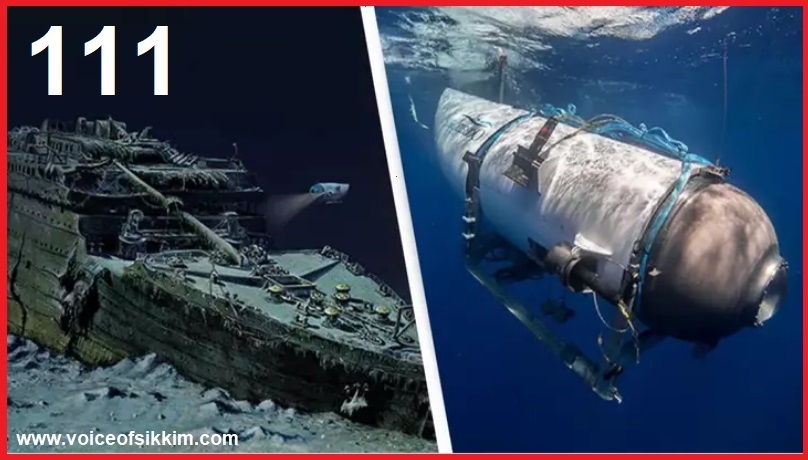
A century and a decade apart, the destinies of Titan and Titanic became intertwined, linking them through a tragic connection.
Titan, a deep-sea submersible, embarked on an expedition to explore the depths of the Titanic shipwreck. However, its ill-fated journey ended in catastrophe as the vessel succumbed to immense pressure, imploding with its five occupants on board. Presently, both Titan and Titanic rest upon the seabed, residing in a remote expanse of the Atlantic Ocean, merely 490 meters apart, despite the passing of 111 years.
Although their final moments unfolded differently, there exist notable similarities between their stories.

Last Sunday, June 18, marked the launch of Titan. Tragically, it was confirmed on Thursday that the submersible collapsed hours after descending into the depths.
Contrasting the ill-fated fate of Titan, the renowned Titanic, once proclaimed as “unsinkable,” met its demise when it collided with an iceberg on April 14, 1912. This catastrophic event plunged the majestic ship into a frigid, watery grave, claiming the lives of over 1,500 individuals who were aboard.
Operated by OceanGate, the Titan undertook the expedition with a crew of four passengers and a pilot, who also held the position of CEO within the company. Regrettably, all five souls aboard the vessel perished during the ill-fated voyage.
The remnants of the Titan now lie scattered within a close proximity of the Titanic’s bow, merely 1,600 feet (488 meters) away, serving as a somber reminder of the tragic connection between these two ill-fated vessels.
THE FINAL MOMENTS OF TITAN AND THE TITANIC: A CONTRAST IN TRAGEDY
On June 18, the launch of Titan, conducted from a mothership and accompanied by the Canadian research icebreaker Polar Prince, commenced its ill-fated journey. Initial communication between the submersible and its surface ship remained intact.

However, approximately one hour and forty-five minutes into the expedition, an ominous silence engulfed the airwaves as all contact with Titan was abruptly severed. The sudden loss of communication triggered a multinational search effort, spanning the vast expanse of the sea, in a desperate attempt to locate any trace of the ill-fated submersible and its occupants.
Equipped with emergency oxygen supplies, capable of sustaining life for up to 96 hours, the search persisted for four agonizing days. Finally, on Thursday, hope gave way to despair as the debris of Titan was discovered, confirming the devastating outcome that was feared all along.
Reports emerged, revealing that the United States Navy had detected a loud and cataclysmic noise, coinciding with the moment Titan ceased all communication. This deafening sound signified the catastrophic implosion that brought an end to the vessel and the lives of its five occupants. Tragically, those on board Titan were likely unaware of the impending disaster that awaited them.

In stark contrast, the sinking of the Titanic unfolded in a different manner. The colossal engineering marvel, renowned for its grandeur, remained afloat for a staggering two hours and forty minutes after colliding with the iceberg.
Unlike the unsuspecting fate of those on Titan, the passengers aboard the Titanic were granted a grim premonition of their impending doom. They bore witness to the approaching catastrophe and faced a harrowing decision: either securing their place on a lifeboat for self-preservation or selflessly sacrificing their position to save others. In the midst of mass panic, countless passengers and crew members found themselves plunged into the frigid waters.
Thus, while the final moments of Titan and the Titanic were united by tragedy, their narratives diverged in critical ways. Titan succumbed to an unforeseen and catastrophic implosion, while the Titanic’s sinking was accompanied by the haunting awareness and selfless acts of its passengers in the face of impending disaster.
WHO WERE ON BOARD? A CONTRAST OF PASSAGES
When the grand Titanic embarked on its ill-fated maiden voyage, it carried with it an air of anticipation and grandeur, hosting a diverse array of individuals who would soon become intertwined in the annals of history.

Implosion of the Titan Submersible: A Devastating Consequence at 13,000 Feet
Operating at extreme depths, where water pressure reaches an astonishing 380 to 400 atmospheres, the Titan Submersible faced a perilous environment akin to the crushing force experienced when squeezing a soda can bottle. Experts speculate that the implosion of the Titan Submersible was triggered by a force of approximately 4,000 tonnes per square meter, a catastrophic event that unfolded with such swiftness that the five occupants aboard had no time to react. According to specialists, the duration of this tragic event could have been measured in mere milliseconds.
Among the approximately 2,200 passengers on board were a multitude of notable figures, including some of the world’s wealthiest individuals, drawn to the allure of the opulent vessel. Additionally, the Titanic welcomed hundreds of emigrants from various parts of Europe, particularly Great Britain and Ireland, who sought a new beginning in the promising lands of North America.
In the present day, venturing to the haunting depths where the Titanic rests has become an exclusive and costly endeavor. Merely a select few, comprising salvagers and researchers, have dared to descend to the abyssal depths of approximately 13,000 feet, immersing themselves in the relics of the sunken titan.

Contrasting the grandeur and scale of the Titanic, the ill-fated Titan carried a smaller but notable group of individuals on its ill-fated expedition. Among the five passengers were Stockton Rush, the pilot of the submersible and the CEO of OceanGate Expeditions. Accompanying him were British billionaire explorer Hamish Harding, French diver Paul-Henri Nargeolet, and Pakistani businessman Shahzada Dawood and his 19-year-old son, Suleman Dawood. These adventurers, driven by their own curiosity and perhaps a touch of daring, embarked on the Titan’s ill-fated voyage.
It is reported that each passenger on the Titan paid a staggering $250,000 for the privilege of occupying a seat within the confines of the submersible, a testament to the allure and exclusivity of the underwater expedition.
Thus, the two vessels, the Titanic and the Titan, carried a diverse tapestry of individuals, each with their own aspirations and dreams, forever bound by the tragic circumstances that awaited them on their respective journeys.
DISTRESS SIGNALS AND SURVIVORS: A CONTRAST OF RESPONSES
In the tragic accounts of the Titan and the Titanic, the contrasting circumstances surrounding distress signals and the fate of survivors further illuminate the stark differences between these ill-fated voyages.
The Titan, consumed by an implosion, was unable to emit any distress signals. The sudden and catastrophic nature of the event left no time for the crew to transmit a call for assistance. Without warning, the submersible met its untimely demise, leaving no opportunity for intervention.

Conversely, the Titanic’s fateful encounter with an iceberg on April 14 was accompanied by several warnings from nearby ships, cautioning of the presence of ice in the vicinity. In response to the imminent danger, the Titanic transmitted an SOS message at 11:40 pm. Distress signals were sent, although the initial vessel closest to the Titanic, the SS Californian, failed to grasp the urgency due to miscommunication. However, the RMS Carpathia, positioned at a greater distance, responded promptly and set out on a rescue mission.
Yet, both the Titanic and the Titan were ill-equipped to handle the dire circumstances they faced.
In the case of the Titanic, lifeboat operations commenced swiftly but proved inefficient, resulting in the launch of partially filled lifeboats. Furthermore, the ship itself lacked an adequate number of lifeboats. Despite having a capacity to accommodate around 3,500 individuals, the Titanic carried lifeboats suitable for only approximately 1,178 people.
At 2:20 am on April 15, the Titanic succumbed to its tragic fate, splitting into two and sinking into the icy depths of the North Atlantic. The RMS Carpathia arrived at approximately 4 am, providing much-needed rescue for the survivors who had taken refuge in the available lifeboats.

Tragically, only about 710 individuals, primarily women and children in adherence to the “women and children first” protocol, managed to survive the disaster. The loss of life reached a devastating toll, with over 1,500 passengers and crew members meeting their untimely demise. This marked the Titanic as one of the deadliest commercial peacetime maritime disasters in modern history.
In the case of the Titan, the absence of escape pods and the inability to open the hatch from the inside sealed the fate of the five individuals on board the submersible. None survived the tragic implosion that befell the vessel.
The sinking of the Titanic spurred significant changes in maritime legislation, leading to the establishment of the International Ice Patrol and the implementation of enhanced communication protocols. However, it remains to be seen whether the implosion of the Titan will incite similar transformations. Only time will reveal the impact of this tragic event on maritime practices and regulations.
For breaking news and live news updates, like us on Facebook fb.com/thevoiceofsikkim or follow us on Twitter twitter.com/thevoicesikkim and Instagram instagram.com/thevoiceofsikkim. Visit www.voiceofsikkim.com.






